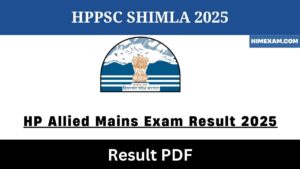Important Question Answer Series For HPSSC JOA Accounts (Post Code -932) Set-1
||Important Question Answer Series For HPSSC JOA Accounts (Post Code -932) Set-1||Important Question Answer Series For HPSSSB Junior Office Assistant Accounts (Post Code -932) Set-1||
1. In setting the accounts of a firm after its dissolution the assets of the firm shall be applied first in paying
(a) Each partner proportionately what is due to him on account of loans advanced by him
(b) Each partner proportionately what is due to him on account of capital
(c) Each partner proportionately what is due to him on account of past profits
(d) The debts of the firm to third parties
2. Capital employed in a business is Rs. 1,50,000, profits are Rs. 50,000 and the normal rate of profit
is 20%. The amount of goodwill as per capitalisation method would be
(a) Rs. 1,00,000
(b) Rs. 1,50,000
(c) Rs. 2,00,000
(d) Rs. 3,00,000
3. ‘A’ and ‘B’are sharing profits and losses in the ratio of 4:1 ‘C’ is admitted as a new partner for 1/ 3rd share of profits for which he pays Rs. 30,000 as goodwill. If A’and ‘B’agree to share future profits equally, then the amount of goodwill to be credited to ‘A’ would be
(a) Rs. 30,000
(b) Rs. 90.000
(c) Rs. 48,000
(d) Rs. 42,000
4. Assertion (A) : Share premium amount can be refunded in cash to equity share holders
Reason (R) • Share premium is usually collected when the market price of the shares is higher than the face value of the share
In the context of the above two statements, which one of the following is correct?
(a) Both A and R are true, but R is the correct explanation of A
(b) Both A and R are true, but R is NOT correct explanation of A
(c) A is true, but R is false
(d) A is false,but R is true
5. Match List I with List II and select the correct answer from the codes given below the lists:
List I (Item) List II (Nature of Item)
I. Cash A. Share holder’s equity
II. Profits B. Fixed assets
III. Discount on issue C. Current assets of shares
IV. Plant and machinery D. Fictitious assets
E. Intangible assets
Codes :
(a) I-B, II-E, III-A, IV-C
(b) I-C, II-A, III-D, IV-B
(C) I-C, II-D, III-D, IV-E
(d) I-A, II-C, III-D, IV-B
6. When a goodwill account is raised at the time of admission of a new partner, credit is given to old partners in their
(a) New profit sharing ratio
(b) Old profit sharing ratio
(c) Ratio of sacrifice
(d) Capital ratio
7. A and B were equal partners in a firm on 1.1.1982, they admitted C on the following conditions:
C should bring Rs. 10,000 as capital, and Rs. 5,000 as goodwill. In future A, B and C would share profits and losses in the ratio of 2: 1:2. A and B will share the goodwill in the ratio of
(a) 1:1
(b) 3:1
(c) 1:3
(d) 2:1
8. On 31st December 1982, the assets and liabilities of a firm were Rs. 40,000 and Rs. 30,000 respectively
The firm was dissolved and a sum of 60 paise in a rupee was paid to the creditors. What was the loss on realisation?
(a) Rs. 10,000
(b) Rs. 12,000
(c) Rs. 18,000
(d) Rs. 22,000
9. When an incoming partner purchases his share from one of the existing partners
(a) The total assets of the firm do not change.
(b) The assets of the firm will be augmented to the extent of the payment received from the new partner.
C) The assets of the firm will be augmented to the extent of the payment received from the new partner and existing partner with draws the share surrendered.
(d) The changes in the total assets of the firm will depend upon the structure of the assets.
10. While preparing the final accounts from incomplete records, the capital is to be taken as Equal to the
(a) Value of fixed assets.
(b) Total assets.
(c) Difference between the current assets and current liabilities.
(d) Net assets.
11. Profit on reissue of forfeited shares is transferred to
(a) Profit and loss A/C
(b) Capital reserve A/c
(c) Share capital A/C
(d) General reserve Alc
12. Consider the following items which appear under “Reserves and Surplus” of balance sheet of a company
I. Profit and loss Account
II. Capital Redemption Reserve
III, Share Premium
IV. Capital Reserve
The correct sequence of these items is
(a) IV, II, III, I
(b) IV, III, II, I
(c) I, II, III, IV
(d) II, IV, III, 1
13. The term current assets does not include
(a) Stock
(b) Cash
(c) Advance payment
(d) Furniture
14. Bonus share are issued by the companies because
(a) Surplus cash is available.
(b) There are heavy accumulated general reserves
(C) There is heavy competition from similar companies.
(d) They have high gross profit ratio.
15. Profit can be fraudulently inflated by
(a) Suppression of sales returns.
(b) Treating capital expenditure as revenue.
(c) Overestimation of liabilities,
(d) Omission of prepaid expenses.
16. The trial balance of a manufacturing concern at the close of its financial year showed the following revenue balances Rs.
Raw materials and stores consumed 2,00,000
Salaries and wages 50,000
Other manufacturing expenses 1,00,000
Sales 3,00,000
The closing stock at selling rates amounted to Rs. 80,000. The management wants to change the basis of valuation of closing stock from selling rates to cost or market price, whichever is lower. Besides the figures given above, no other data are available
The closing stock value is
(a) Rs. 83,674.30 (b) Rs. 75,933.50 (c) Rs. 73,684.22 (d) Rs. 64,385.40
17. What is the correct sequence in which the capital of a company is raised?
(a) Issued, Nominal, Subscribed, Called-up.
(b) Issued, Nominal, Calledup, Subscribed.
(c) Nominal, Issued, Called-up, Subscribed.
(d) Nominal, Issued, Subscribed, Called-up.
18. Secret reserves may result by
(a) Creating general reserve.
(b) Providing excessive depreciation.
(c) Over valuation of stocks,
(d) Under valuation of liabilities,
19. Which of the following is not a capital reserve?
(a) Profits prior to incorporation.
(b) Dividend equalisation reserve.
(c) Profit on sale of fixed assets.
(d) All of these
20. Which of the following is created by debiting the Profit and Loss Account?
(a) Provision
(b) Sinking fund for redemption of debentures
(c) Dividend equalisation fund
(d) All of these.









